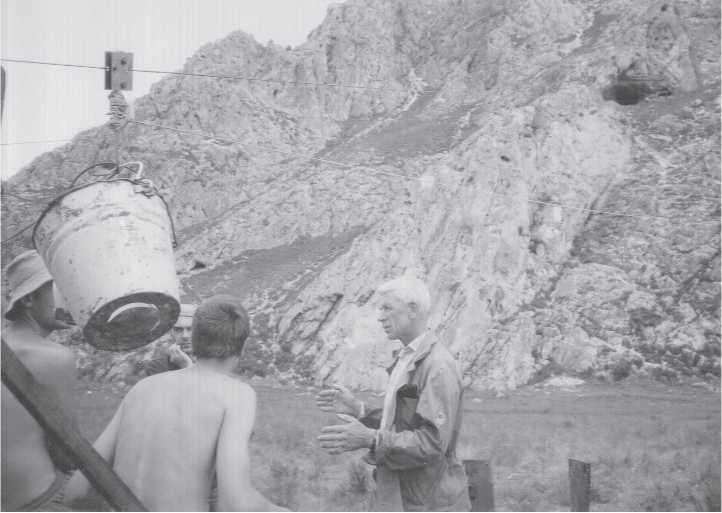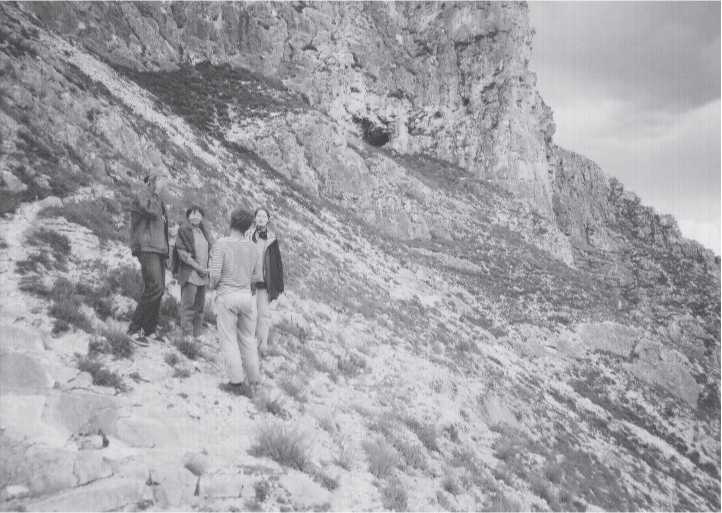Ust-Kan is a cave site 3.5 km east of the Altai Republic mountain town and local administrative center of the same name. The cave is located at 50°54'40" N, 84°48'50" E (Derevianko et al. 2001b:130). The cave opening is about half way up (52 m) a steep, rounded limestone butte set apart in the surrounding steppe plain from nearby forested hills and more distant mountains (Figs. 3.152 and 3.153). Not far from the base ofthis butte a clear mountain river rushes northward in the Charysh River valley and through the town. Its water eventually reaches the Arctic Ocean via the Ob River.
The 8.3 m wide, 16.7m deep, and 10m high cave (Derevianko and Markin 1998:85) was first tested in 1954 by archaeologist Sergei I. Rudenko (1960,1961). Derevianko and Markin (1998) lay out a brief history and summary of the stratigraphy, recovered materials, cultural affinity, and reconstructed environment based on Rudenko’s excavation (Fig. 3.154). They provide no carbon-14 dates for Ust-Kan, nor does the recent inventory and interpretation of Siberian Paleolithic dates compiled by Vasili’ev et al. (2002). On the basis of 520 artifacts, Derevianko and Markin conclude that the cave dwellers had a late Mousterian tool kit. There is no physical evidence of the dwellers themselves. Of 1749 pieces of late Pleistocene faunal remains recovered by Rudenko, one-third (532) could be identified as to species - 17 of which were mammalian and 12 avian. Elsewhere, L. I. Galkina and N. D. Ovodov (1975) report that only 12 species of mammals had been identified by Vereschagin. The inventory suggests a combination of species that lived in open spaces and forest, as well as being moderate-temperature and cold-loving, which altogether implied an arid, treeless Central Asian plateau landscape surrounded by mountain forests. This would match to a large degree the botanical landscape today. Large carnivores included cave bear, wolf, and cave hyena. More recently, cave lion has been added to this list as a result of Patrick Wrinn’s finding two paw fragments (Postnov and Karavaeva 2005) in the Ust-Kan osteological assemblage of “layer 5, cave 2.” Ust-Kan stratigraphy is far fTom simple (Agadjanyan et al. 2002). This condition we propose involves much carnivore bioturbation.
An undisturbed hearth was discovered. It was given special study, including the surrounding rock structure (Postnov and Kulik 2003). It serves as a reminder to us that bioturbation missed some fraction of the midden deposit, but the amount has not yet been estimated.

Fig. 3.152 Ust-Kan site. The cave is in the upper right comer of this view, 52 m above the valley floor on which the people are standing. An aerial cable and bucket system carries excavated midden down to the edge of the Charysh River, where Nicolai Ovodov (right) explains to student workers his paleontological identifications fTom previous summer excavations supervised by IAE archaeologist Alexander Postnov. The aerial cable system is a continuous loop of heavy single-strand wire that is propelled by the weight of a filled bucket as it descends from the cave to the river below, where its contents are water-screened. An empty bucket is propelled up to the cave on the returning loop of cable (CGT color Ust-Kan 7-12-99:26).
There is an extensive Russian literature on Ust-Kan, in addition to those cited above. Most are based on the materials recovered by field supervisor Alexander V. Postnov: Derevianko et al. (1998j, 1999c, 1999d, 2000a, 2001a, 2001b, 2002a, 2003d, 2004); Postnov and Kulik (1998); Postnov and Karavaeva (2005); among others.
More recent fieldwork led by A. P. Derevianko and supervised by Alexander V. Postnov took place in the late 1990s, continuing into the first years of this century. Our inspection of Ust-Kan was on July 12, 1999 (Figs. 3.155-3.156). On that date, Postnov explained to us his understanding of the archaeology, and of how Ust-Kan was formed - by faulting and earthquake activity, unlike the karst solution caverns elsewhere in the Altai. Postnov could readily demonstrate that some of the troubling past interpretative problems are due to Rudenko’s excavation methods. However, as will be shown, these stratigraphic problems very likely began long before Rudenko’s excavation. The possibility of Ust-Kan bioturbation is not mentioned by Derevianko et al. (2001b). We did not examine the Rudenko faunal finds. Our sample came entirely from the IAE excavations of Postnov and associates.

Fig. 3.153 Ust-Kan site. Of all the Altai cave sites excavated by lAE archaeologists, Ust-Kan is the most difficult to reach, making it both highly defendable and a trap. The difficulty arises fTom the steepness (notice that the slope at the upper left and bottom right form a right-angled triangle), and the loose, broken rock covering the slope. The climb would have made winter use of Ust-Kan undesirable because of the effort it would have taken to haul firewood up to the cave. Catching their breath are, left to right: Nicolai Martynovich, Olga Pavlova, Alexander Postnov, and a female student (CGT color Ust-Kan 7-12-99:35).




 World History
World History









